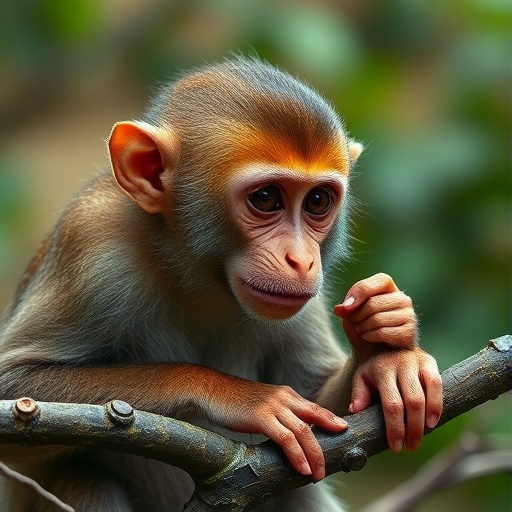In the rapidly evolving landscape of infectious diseases, a groundbreaking exploration into the immune response strategies of primates is setting new directions for biomedical research and therapeutic innovation. Recognizing that humans are great apes and thus part of the primate family tree, scientists have launched an ambitious quest to decode the evolutionary signatures embedded in immune system adaptations across nearly 500 primate species.
This expansive inquiry addresses a fundamental challenge in immunology: how evolutionary history shapes the body’s arsenal against pathogens. The implications extend far beyond academic curiosity, reaching into serious human health concerns such as HIV and other viral threats. Understanding the immune strategies that different primate species have employed enables researchers to identify both vulnerabilities and strengths that could inform the design of next-generation treatments and vaccines.
The complexity of this endeavor stems from a glaring gap in comprehensive comparative data spanning the diverse phylogenetic branches of primates. Immune response mechanisms exhibit an astonishing variety, influenced not only by genetic lineage but also by species-specific life history traits—a nexus that has yet to be fully mapped. As a result, no clear consensus exists regarding which taxonomic levels contribute most significantly to variation in immune function, underscoring the need for more refined, species-inclusive research.
Despite the scale of this challenge, scientists are adopting a pragmatic framework to maximize insights. Instead of seeking exhaustive data for all immune aspects and all species—a task that would overwhelm laboratories and budgets—they advocate for strategically increasing species representation in key research areas. By honing in on phylogenetically informative lineages and immune features, the field can more efficiently unlock evolutionary patterns relevant to human health.
One deeply studied area is the intersection of primate immune responses with HIV and its simian counterpart, SIV. While some primates such as humans and certain chimpanzees progress to the often-fatal acquired immunodeficiency syndrome (AIDS) upon infection, others harbor the virus without succumbing to disease. This natural resilience prompts questions about molecular players like tripartite motif-containing protein 5 (TRIM5), which targets retroviral capsids to restrict infection, or interferon-induced transmembrane proteins (IFITMs), crucial innate immune factors that block viral entry and replication.
Further, the role of adaptive immunity, including the function of major histocompatibility complex (MHC) molecules and killer immunoglobulin-like receptors (KIR) on natural killer cells, reveals a landscape of polymorphic gene families tailored by evolution to recognize and eliminate diverse pathogens. These receptor systems exemplify a molecular arms race, where host recognition capabilities continually adapt against pathogen evasion strategies.
Emerging technologies also promise to revolutionize comparative immunology in primates. For example, massively parallel reporter assays (MPRA) allow researchers to simultaneously assess thousands of DNA sequences for regulatory activity, pinpointing genetic elements that control immune responses with unprecedented precision. Moreover, induced pluripotent stem cells (iPSCs) derived from diverse primate species may pave the way for in vitro modeling of immune tissues, circumventing limitations in sample availability.
The innate immune system’s first responders, such as toll-like receptors (TLRs), detect pathogen-associated molecular patterns (PAMPs), initiating signaling cascades that trigger inflammation and pathogen clearance. Yet, these processes can be finely balanced by regulators like interleukin-1 receptor antagonist (IL-1Ra), which competes with pro-inflammatory signals to prevent excessive tissue damage—a dynamic that varies widely across species.
The soluble urokinase plasminogen activator receptor (suPAR), circulating in plasma as an immune activation marker, illustrates another dimension of immune system modulation. Its concentration reflects ongoing immune responses, offering a non-invasive biomarker to compare immune activation states among species with different disease susceptibilities.
Primate evolutionary history also shapes mucosal immunity strategies, with immunoglobulin A (IgA) antibodies playing a critical role in protecting mucosal surfaces from bacterial and viral invasion. The diversity in IgA responses among primates points to adaptive fine-tuning, potentially linked with distinct microbial exposures and social behaviors.
As remarkable as these immunological insights are, the true power of this research lies in its translational potential. By integrating evolutionary biology, comparative genomics, and molecular immunology, scientists are constructing a framework that could illuminate why some species thrive despite persistent viral exposure while others deteriorate. This knowledge is vital for developing therapies that leverage natural defense mechanisms honed over millions of years.
The path forward calls for a collaborative effort integrating field studies, high-throughput sequencing, and cellular immunology. Understanding at which taxonomic levels immune responsiveness varies most—be it genus, family, or order—will impact how we prioritize species for study and how we interpret human immune diversity in a broader evolutionary context.
This lens also invites reconsideration of the one-health paradigm, emphasizing the interconnectedness of human, animal, and ecosystem health. By studying immune systems across the primate spectrum, researchers can anticipate zoonotic spillovers and design preemptive interventions that address the root evolutionary vulnerabilities exploited by pathogens.
In conclusion, this transformative exploration of primate immune variation marks a significant leap toward harnessing evolutionary wisdom in tackling infectious diseases. It expands the frontier of immunological research and sets the stage for breakthroughs that will ripple across medicine and public health. As this ambitious inquiry unfolds, it will not only decode primate biology but also illuminate pathways to resilience in the face of emerging global health threats.
Subject of Research: Taxonomic variation in immune response strategies among primates
Article Title: Taxonomic variation in immune response strategies among primates
Article References:
Joseph, S.K., Lucore, J.M., Lindo, J. et al. Taxonomic variation in immune response strategies among primates. Genes Immun (2025). https://doi.org/10.1038/s41435-025-00363-1
Image Credits: AI Generated
DOI: https://doi.org/10.1038/s41435-025-00363-1
Tags: biomedical research on primatescomparative immunology of primatesevolutionary adaptations in primatesHIV immune response studieshuman health implications of primate immunologyimmune function variation in primatesinfectious disease researchnext-generation therapeutic innovationsphylogenetic diversity in immune systemsprimate immune response strategiesspecies-specific immune mechanismsvaccine development from primate studies





